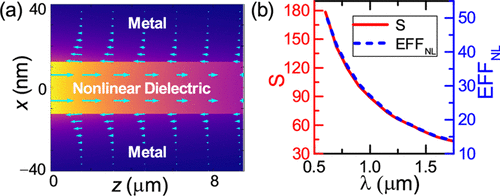当前位置:
X-MOL 学术
›
ACS Photonics
›
论文详情
Our official English website, www.x-mol.net, welcomes your feedback! (Note: you will need to create a separate account there.)
Fundamental Limitations to the Ultimate Kerr Nonlinear Performance of Plasmonic Waveguides
ACS Photonics ( IF 7 ) Pub Date : 2018-01-12 00:00:00 , DOI: 10.1021/acsphotonics.7b01331 Guangyuan Li , C. Martijn de Sterke , Stefano Palomba
ACS Photonics ( IF 7 ) Pub Date : 2018-01-12 00:00:00 , DOI: 10.1021/acsphotonics.7b01331 Guangyuan Li , C. Martijn de Sterke , Stefano Palomba

|
Plasmonic waveguides can greatly enhance nonlinear light–matter interactions through strong field confinement. However, achieving high performance nonlinear plasmonic devices remains challenging because of optical losses and material damage. Here we investigate the ultimate Kerr nonlinear performance of plasmonic waveguides. We account for optical damage by requiring that the local electric field intensity does not exceed the damage threshold of the nonlinear material. This allows us to factorize the fundamental limitations into those stemming from the constituent materials’ linear and nonlinear properties, and from the mode characteristics. We define quality coefficients for the metal and for the nonlinear dielectric so that these materials can be selected appropriately, and illustrate their utility by application to surface plasmon polaritons (SPPs). We further propose the concept of nonlinear effectiveness in order to quantify a mode’s ability to exploit the material’s nonlinearity. We find that the full exploitation of the material’s maximum nonlinearity requires a uniform field in addition to slow light effects. This is exemplified by the discovery that the maximum nonlinearity of Metal–Dielectric–Metal structures can be stronger than that of the bulk material. These counterintuitive insights provide deep understanding into the ultimate performance of nonlinear waveguides, and point to novel approaches to achieve practical, high performance nonlinear plasmonic devices.
中文翻译:

等离子体波导管极限Kerr非线性性能的基本限制
等离子波导可以通过强场限制来极大地增强非线性光-物质的相互作用。然而,由于光学损失和材料损坏,实现高性能非线性等离激元器件仍然具有挑战性。在这里,我们研究了等离激元波导的极限Kerr非线性性能。我们通过要求局部电场强度不超过非线性材料的损伤阈值来解决光学损伤。这使我们能够将基本限制因素分解为由构成材料的线性和非线性特性以及模式特性引起的那些限制。我们定义了金属和非线性电介质的质量系数,以便可以适当地选择这些材料,并通过应用于表面等离激元极化子(SPPs)来说明其实用性。我们进一步提出了非线性有效性的概念,以便量化模式利用材料非线性的能力。我们发现,要充分利用材料的最大非线性,除了需要缓慢的光效应外,还需要一个均匀的场。通过发现金属-电介质-金属结构的最大非线性度可以比块状材料的最大非线性度更充分地证明了这一点。这些与直觉相反的见解提供了对非线性波导最终性能的深入了解,并指出了实现实用,高性能非线性等离激元器件的新颖方法。我们发现,要充分利用材料的最大非线性,除了需要缓慢的光效应外,还需要一个均匀的场。通过发现金属-电介质-金属结构的最大非线性度可以比块状材料的最大非线性度更充分地证明了这一点。这些与直觉相反的见解提供了对非线性波导最终性能的深入了解,并指出了实现实用,高性能非线性等离激元器件的新颖方法。我们发现,要充分利用材料的最大非线性,除了需要缓慢的光效应外,还需要一个均匀的场。通过发现金属-电介质-金属结构的最大非线性度可以比块状材料的最大非线性度更充分地证明了这一点。这些与直觉相反的见解提供了对非线性波导最终性能的深入了解,并指出了实现实用,高性能非线性等离激元器件的新颖方法。
更新日期:2018-01-12
中文翻译:

等离子体波导管极限Kerr非线性性能的基本限制
等离子波导可以通过强场限制来极大地增强非线性光-物质的相互作用。然而,由于光学损失和材料损坏,实现高性能非线性等离激元器件仍然具有挑战性。在这里,我们研究了等离激元波导的极限Kerr非线性性能。我们通过要求局部电场强度不超过非线性材料的损伤阈值来解决光学损伤。这使我们能够将基本限制因素分解为由构成材料的线性和非线性特性以及模式特性引起的那些限制。我们定义了金属和非线性电介质的质量系数,以便可以适当地选择这些材料,并通过应用于表面等离激元极化子(SPPs)来说明其实用性。我们进一步提出了非线性有效性的概念,以便量化模式利用材料非线性的能力。我们发现,要充分利用材料的最大非线性,除了需要缓慢的光效应外,还需要一个均匀的场。通过发现金属-电介质-金属结构的最大非线性度可以比块状材料的最大非线性度更充分地证明了这一点。这些与直觉相反的见解提供了对非线性波导最终性能的深入了解,并指出了实现实用,高性能非线性等离激元器件的新颖方法。我们发现,要充分利用材料的最大非线性,除了需要缓慢的光效应外,还需要一个均匀的场。通过发现金属-电介质-金属结构的最大非线性度可以比块状材料的最大非线性度更充分地证明了这一点。这些与直觉相反的见解提供了对非线性波导最终性能的深入了解,并指出了实现实用,高性能非线性等离激元器件的新颖方法。我们发现,要充分利用材料的最大非线性,除了需要缓慢的光效应外,还需要一个均匀的场。通过发现金属-电介质-金属结构的最大非线性度可以比块状材料的最大非线性度更充分地证明了这一点。这些与直觉相反的见解提供了对非线性波导最终性能的深入了解,并指出了实现实用,高性能非线性等离激元器件的新颖方法。



























 京公网安备 11010802027423号
京公网安备 11010802027423号